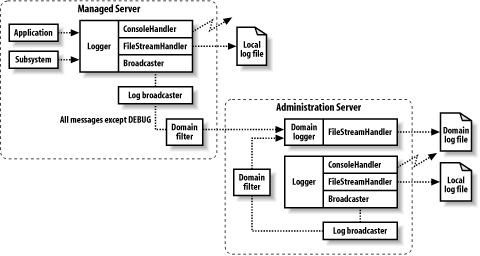The Logging Architecture
WebLogic provides various facilities to create, view, and listen for log messages. Its internal subsystems, such as its web and EJB containers, constantly generate a number of informational, error, and warning log events while a server is running. These log events are visible on the console window for the server, and also may be found in the appropriate log files.
WebLogic manages a distributed log infrastructure. A typical domain is composed of an Administration Server and one or more Managed Servers. The logging infrastructure supports a Logger on each server, which collects the log events generated by your own applications and WebLogic’s internal subsystems. These messages then are written to a log file and console that is local to each server instance. In addition, the Logger forwards all but the debug-level messages to a Log Broadcaster. The Log Broadcaster then sends these messages through an optional filter to the Domain Logger on the Administration Server. The Domain Logger gathers all of the messages received from the different servers in the domain and writes these messages to a unified log called the domain log file. This distributed logging infrastructure is depicted in Figure 21-1.

Figure 21-1. The distributed logging architecture
The logging architecture is extensible, letting you create your own set of log messages. You then can instrument your ...
Get WebLogic: The Definitive Guide now with the O’Reilly learning platform.
O’Reilly members experience books, live events, courses curated by job role, and more from O’Reilly and nearly 200 top publishers.

